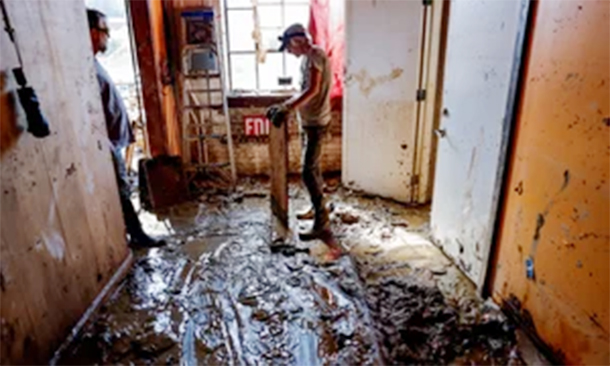Beyond the struggle to recover artworks and personal belongings, local artists worry that rising redevelopment pressures may forever alter the heart of their creative enclave. On the morning of her return to the RAD, artist Elizabeth Porritt Carrington drove from West Asheville to what she called her “village.” This once-lively hub, filled with art galleries, studios, and restaurants, has become a battered landscape since the French Broad River surged to a historic 24 feet on September 28. The floodwaters receded, but they left behind scenes of devastation: sideways trees, tangled sheets of metal, shredded plastic caught in branches, and thick mud coating every surface. Carrington’s studio space was inside Riverview Station, a historic 1902 building that had provided affordable studios for more than 60 artists. On that first visit back, Carrington discovered a few of her prints—water-damaged and warped—spread across the grass outside Tyger Tyger Gallery on the building's lower floor. Someone had placed them out to dry under the sun.With an N95 mask covering her face to guard against the toxins in the mud, Carrington carefully inspected the gallery, worried she might find one of her paintings stuck in the building’s rafters. “How do you hose down an oil painting?” she asked, knowing that the value of artworks contaminated by toxic floodwater would be nearly impossible to recover.A Difficult Path to Recovery
Carrington’s studio space was inside Riverview Station, a historic 1902 building that had provided affordable studios for more than 60 artists. On that first visit back, Carrington discovered a few of her prints—water-damaged and warped—spread across the grass outside Tyger Tyger Gallery on the building's lower floor. Someone had placed them out to dry under the sun.With an N95 mask covering her face to guard against the toxins in the mud, Carrington carefully inspected the gallery, worried she might find one of her paintings stuck in the building’s rafters. “How do you hose down an oil painting?” she asked, knowing that the value of artworks contaminated by toxic floodwater would be nearly impossible to recover.A Difficult Path to Recovery
The RAD is one of the Southeast's most respected artistic hubs, home to around 300 working artists. Like Carrington, many believed the sturdy old industrial buildings in the district could weather the storm. However, Riverview Station and others proved vulnerable. Without power, artists returned to find their studios in eerie darkness, with waterlogged floors and mud-filled halls. Some artworks were salvageable, but others were destined for discard piles. Sketchbooks, canvases, and childhood mementos—things that could never be replaced—were destroyed.Even before the storm, Carrington relied on community galleries to sell her work. While her personal art was saved in part by gallerists who relocated pieces to higher floors, the loss of physical spaces now leaves her scrambling to shift online. “I need to rebuild from the ground up,” Carrington reflected. “I trust myself to do it, but I don’t yet know what it looks like.”Mixed-media artist Bridget Benton shares Carrington’s concerns. “The River Arts District was something entirely unique,” Benton said. “But rebuilding won’t be easy.” Many worry that real estate developers will seize the opportunity to profit from the destruction. With the RAD’s older, affordable spaces crumbling, large developers could replace them with high-end galleries, pushing out the smaller makers who gave the district its charm.Nikki Eldred, who opened Asheville Dispensary, a tea and elixir bar in the RAD just a month before the hurricane, echoed those fears. “I’m afraid developers will bulldoze everything and build things that don’t reflect the heart of Asheville,” she said. “I’m trying not to give in to that fear, but it’s hard.”Regrouping Amid Financial Losses
Artists now face another urgent problem: revenue loss during peak tourism season. Fall’s leaf season usually draws billions in tourist dollars to the region, but road closures and water outages have prompted the governor to advise visitors to stay away. “How are we supposed to generate income now?” Benton asked.310 Art, a fine art school where Benton worked as an instructor, was heavily damaged, forcing staff to consider temporary relocation. Benton envisions hosting workshops like collage nights or watercolor sessions to generate income—similar to the community efforts that kept spirits alive during the early days of COVID-19. Meanwhile, ArtPlay Gallery has shifted to online sales, directing 75% of proceeds to artists in need. Carrington managed to sell a $600 piece through ArtPlay’s platform, though she admits digital sales were never her focus. “I depended on the RAD and physical galleries,” she said.Many artists are also feeling pressure to fundraise while public attention remains on the disaster. “Everyone’s saying, ‘Where’s your GoFundMe page?’” Benton shared. “If we don’t act now, people might stop caring in a week.” Carrington recognizes that embracing online platforms is no longer optional but essential to rebuilding her career. “I’ve got to change everything,” she admitted. “I know I’ll figure it out, but I’m not sure yet what that future looks like.”Preserving the Heart of RAD
For now, the artists of the River Arts District are navigating survival and recovery, hoping to restore the spirit of what made their community special. But as they contend with immediate challenges—mud-covered canvases, lost income, and unstable buildings—they also face deeper fears. Can they rebuild the RAD without sacrificing its soul to gentrification?Despite the uncertainty, the creative spirit of Asheville persists. As Carrington and others piece together what’s left, they do so with determination, knowing that art has always been a way to heal and rebuild—no matter how muddy the canvas.
 Carrington’s studio space was inside Riverview Station, a historic 1902 building that had provided affordable studios for more than 60 artists. On that first visit back, Carrington discovered a few of her prints—water-damaged and warped—spread across the grass outside Tyger Tyger Gallery on the building's lower floor. Someone had placed them out to dry under the sun.With an N95 mask covering her face to guard against the toxins in the mud, Carrington carefully inspected the gallery, worried she might find one of her paintings stuck in the building’s rafters. “How do you hose down an oil painting?” she asked, knowing that the value of artworks contaminated by toxic floodwater would be nearly impossible to recover.A Difficult Path to Recovery
Carrington’s studio space was inside Riverview Station, a historic 1902 building that had provided affordable studios for more than 60 artists. On that first visit back, Carrington discovered a few of her prints—water-damaged and warped—spread across the grass outside Tyger Tyger Gallery on the building's lower floor. Someone had placed them out to dry under the sun.With an N95 mask covering her face to guard against the toxins in the mud, Carrington carefully inspected the gallery, worried she might find one of her paintings stuck in the building’s rafters. “How do you hose down an oil painting?” she asked, knowing that the value of artworks contaminated by toxic floodwater would be nearly impossible to recover.A Difficult Path to RecoveryThe RAD is one of the Southeast's most respected artistic hubs, home to around 300 working artists. Like Carrington, many believed the sturdy old industrial buildings in the district could weather the storm. However, Riverview Station and others proved vulnerable. Without power, artists returned to find their studios in eerie darkness, with waterlogged floors and mud-filled halls. Some artworks were salvageable, but others were destined for discard piles. Sketchbooks, canvases, and childhood mementos—things that could never be replaced—were destroyed.Even before the storm, Carrington relied on community galleries to sell her work. While her personal art was saved in part by gallerists who relocated pieces to higher floors, the loss of physical spaces now leaves her scrambling to shift online. “I need to rebuild from the ground up,” Carrington reflected. “I trust myself to do it, but I don’t yet know what it looks like.”Mixed-media artist Bridget Benton shares Carrington’s concerns. “The River Arts District was something entirely unique,” Benton said. “But rebuilding won’t be easy.” Many worry that real estate developers will seize the opportunity to profit from the destruction. With the RAD’s older, affordable spaces crumbling, large developers could replace them with high-end galleries, pushing out the smaller makers who gave the district its charm.Nikki Eldred, who opened Asheville Dispensary, a tea and elixir bar in the RAD just a month before the hurricane, echoed those fears. “I’m afraid developers will bulldoze everything and build things that don’t reflect the heart of Asheville,” she said. “I’m trying not to give in to that fear, but it’s hard.”Regrouping Amid Financial Losses
Artists now face another urgent problem: revenue loss during peak tourism season. Fall’s leaf season usually draws billions in tourist dollars to the region, but road closures and water outages have prompted the governor to advise visitors to stay away. “How are we supposed to generate income now?” Benton asked.310 Art, a fine art school where Benton worked as an instructor, was heavily damaged, forcing staff to consider temporary relocation. Benton envisions hosting workshops like collage nights or watercolor sessions to generate income—similar to the community efforts that kept spirits alive during the early days of COVID-19. Meanwhile, ArtPlay Gallery has shifted to online sales, directing 75% of proceeds to artists in need. Carrington managed to sell a $600 piece through ArtPlay’s platform, though she admits digital sales were never her focus. “I depended on the RAD and physical galleries,” she said.Many artists are also feeling pressure to fundraise while public attention remains on the disaster. “Everyone’s saying, ‘Where’s your GoFundMe page?’” Benton shared. “If we don’t act now, people might stop caring in a week.” Carrington recognizes that embracing online platforms is no longer optional but essential to rebuilding her career. “I’ve got to change everything,” she admitted. “I know I’ll figure it out, but I’m not sure yet what that future looks like.”Preserving the Heart of RAD
For now, the artists of the River Arts District are navigating survival and recovery, hoping to restore the spirit of what made their community special. But as they contend with immediate challenges—mud-covered canvases, lost income, and unstable buildings—they also face deeper fears. Can they rebuild the RAD without sacrificing its soul to gentrification?Despite the uncertainty, the creative spirit of Asheville persists. As Carrington and others piece together what’s left, they do so with determination, knowing that art has always been a way to heal and rebuild—no matter how muddy the canvas.









